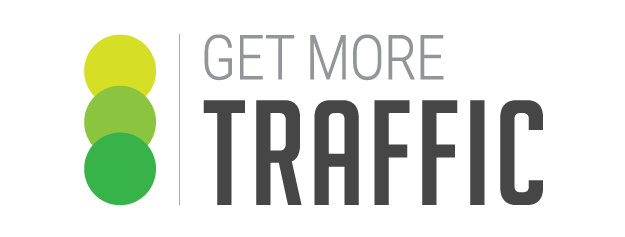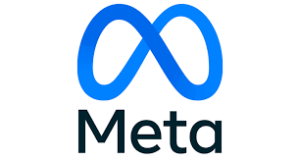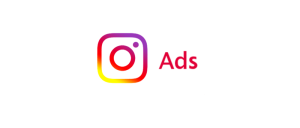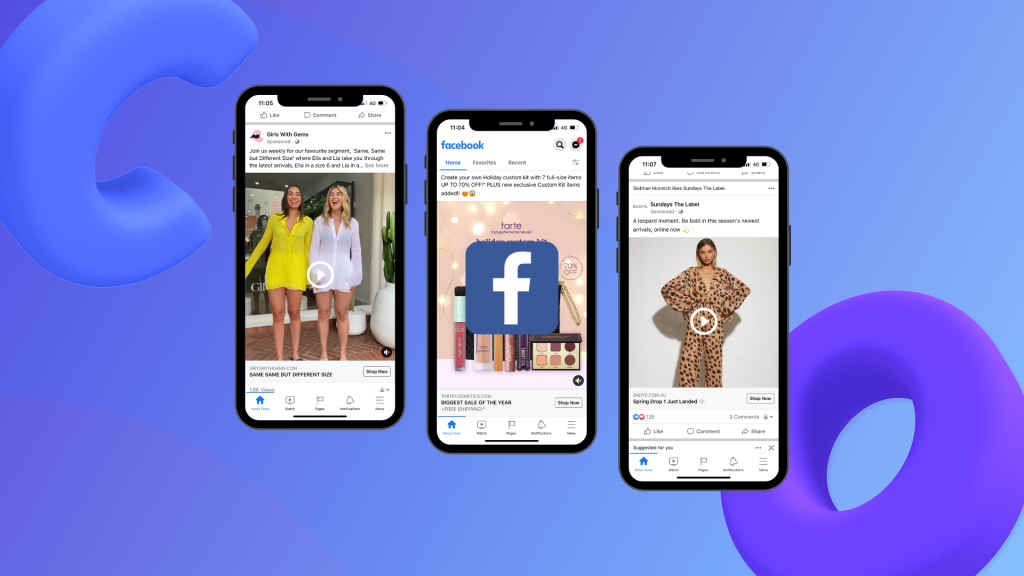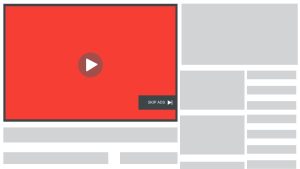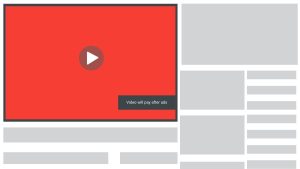Boost Your Business: 10 Quick Social Media Tips for Tradies
Quick Social Media Tips for Tradies
In this modern world, social media has become more than just a way to connect; it’s a powerful tool that can transform businesses and careers. For tradies, harnessing the potential of social media marketing is a game-changer. It means to showcase their craftsmanship, engage with clients, and take their businesses to the next level.
Platforms like Facebook, Instagram, and LinkedIn offer tradies the chance to amplify their skills, tell their stories, and reach a wider audience than ever before. With every post, image, and interaction, tradies can build a brand that stands out and creates lasting impressions.
This guide delves into the essentials of social media marketing for tradies. From choosing the right platforms to crafting compelling content, we’ll navigate the landscape together. Whether you are a seasoned pro looking to expand your reach or a newcomer ready to make a mart, this guide is your roadmap to leveraging social media for your tradie business.
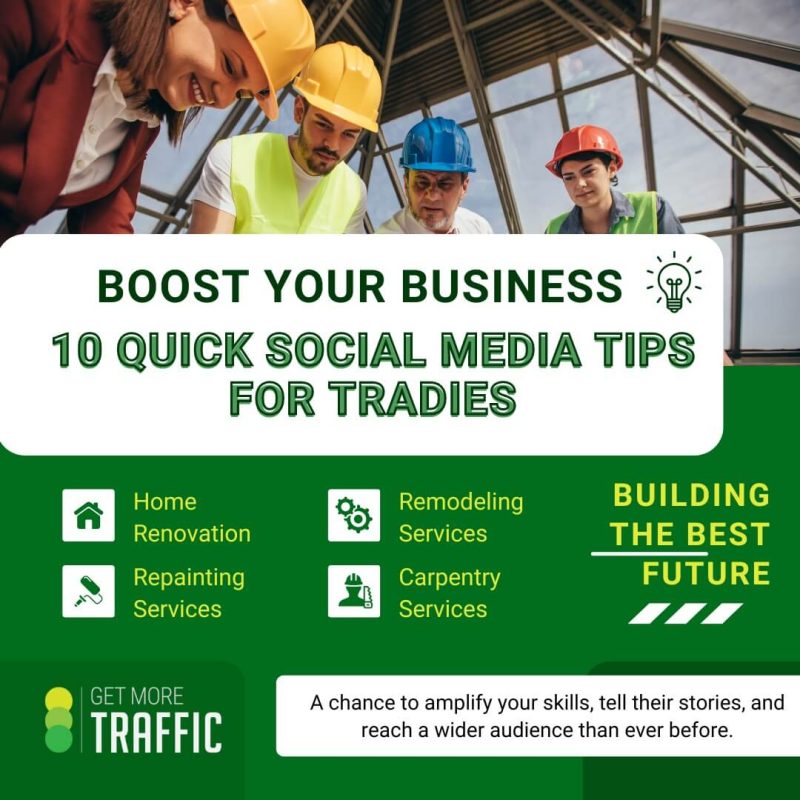
1. Choose the Right Platforms
Focus on platforms that align with your target audience. Selecting the most suitable platforms is a critical step. Not all platforms are created equal, and different platforms attract different demographics and user behaviours. The choice of platforms should align with your target audience and the nature of your trade. Facebook, Instagram, and LinkedIn are popular choices. Instagram is great for visual content, while LinkedIn can be useful for connecting with other professionals and businesses.
2. Optimise Your Profiles
Optimising your profiles is a crucial step in making a strong first impression and establishing credibility on social media platforms. Ensure your profiles are complete, consistent, and professional. Use high-quality profile and cover images, and write a clear and concise bio that highlights your services and expertise. Your platforms serve as the digital storefront for your tradie business, and they should reflect professionalism, expertise, and a clear representation of your services. Some key elements to be focused on include:
- Profile and Cover Images
- Bio and About Section
- Contact information
- Visual elements
- Call to Action (CTA)
4. Showcase Your Work

Visual content is a powerful tool especially for tradies to demonstrate their expertise, creativity, and the transformative impact of their work. When potential clients can see the tangible results you can deliver, it builds trust and excitement. Here is how you can effectively showcase your work:
- Before-and-After Stories:
- Visual transformation: Capture the dramatic change your work brings by posting before-and-after photos. The visual storytelling provides a clear and compelling narrative of your skills
- High-Quality Imagery:
- Attention to Detail: Ensure that the images you share are of high quality, well-lit, and showcase the finer details of your work. Crisp visuals reflect professionalism and attention to detail
- Project Progress Updates:
- Step-by-Step Journey: Use platforms like Instagram to share the progression of your projects. Carousel posts allow you to showcase a series of images, demonstrating the various stages of your work
- Project Descriptions:
- Highlight Key Details: Alongside your images, provide brief descriptions of the projects. Include information like project type, materials used, and any unique aspects that set it apart
- Client testimonials:
- Social Proof: Share testimonials from satisfied clients alongside images of their projects. This combination of visuals and positive feedback strengthens your credibility
4. Engage Authentically
Engaging with your audience authentically is a cornerstone of effective social media marketing. It is not just about broadcasting your message; it is about building relationships, nurturing connections, and establishing your brand as approachable and reliable. By engaging authentically, you foster a sense of connection and community, transforming casual viewers into dedicated followers and potential clients into loyal customers. Genuine interactions leave a lasting impression, contributing to the growth and success of your tradie business.
5. Use Relevant Hashtags
Research and use industry-related and location-specific hashtags to increase the visibility of your posts. Hashtags are like signposts that help users discover content related to specific topics or themes. For tradies, using relevant hashtags strategically can significantly boost the visibility of your posts and attract the attention of potential clients who are searching for services in your industry. Hashtags that are relevant to you include:
- Trending Hashtags – keep an eye on trending hashtags related to your trade
- Platform-Specific Tags – Utilize platform features
- A Branded Hashtag – create a unique hashtag that represents your business
- Local Discovery – Connect with your local community, build a reputation as a trusted trade in your area
6. Educational Content
Educational content is a valuable way to position yourself as an expert in your field and provide real value to your audience. Share informative content related to your field. By sharing tips, how-to guides, and industry insights, you not only demonstrate your expertise but also foster a sense of trust and credibility. Here is how you can effectively create and share educational content:
- Identify Your Audience’s Needs:
- Understand Pain Points and consider the common challenges, questions, and concerns that your clients and potential clients have
- Clear and Concise Content:
- Simplify Complex Concepts by breaking down complex ideas into simple and understandable terms. Use clear language and step-by-step explanations
- Step-by-Step Guides:
- Crafting step-by-step guides for common DIY tasks or maintenance routines
- Industry Insights:
- Stay current and share updates about industry trends, innovations, and news
- Address FAQs:
- Compile a list of frequently asked questions from clients and address them in your content to help preempt doubts and provides quick solutions
7. Customer Testimonials
To build trust and credibility, customer testimonials are a powerful form of social proof that can significantly influence potential clients’ perceptions of your tradie business. By showcasing genuine customer testimonials, you can build a narrative of satisfied clients who have benefited from your services. This form of social proof can be a decisive factor for potential clients considering whether to choose your tradie business.
8. Behind-the-Scenes Content
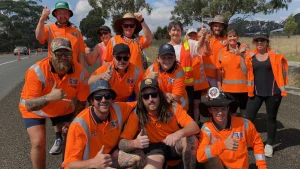
Behind-the-scenes content humanized your brand, offering a glimpse into the people, processes, and stories that drive your tradie business. It adds a personal touch to your online presence, fostering a sense of connection and relatability with your audience. Some behind-the-scenes content include documenting day-to-day activities, highlighting team members, project evolution, problem-solving moments, introducing tools and techniques, showcase craftsmanship, and celebrations and milestones and more.
9. Analytics and Insights
Analytics and insights are valuable tools that provide you with data-driven insights into how your content is performing on social media platforms. By understanding what’s working and what’s not, you can make informed decisions to optimize your strategy for better results. Use the built-in analytics tools on each platform to track the performance of your posts and campaigns. You are able to tailor your content, posting schedule, and overall strategy to match your audience’s preferences and behaviors. Regularly monitoring and analyzing your analytics empowers you to make data-driven decisions that yield more effective results over time.
10. Paid Advertising
Paid advertising on social media offers a powerful way to expand your reach, target specific demographics, and promote your tradie services to a larger audience. Platforms like Facebook, Instagram, and others provide sophisticated tools for precise ad targeting, making your campaigns more effective.It also allows you to tap into the platforms’ extensive user base and finely tune your campaigns to reach the right people at the right time. It is a dynamic tool that can yield impressive results and contribute to the growth of your tradie business.

In conclusion, social media marketing presents a remarkable opportunity for tradies to amplify their businesses, connect with potential clients and establish themselves as trusted experts in their fields. By implementing these strategies, tradies can cultivate a strong online presence, connect with their desired audience, and ultimately drive business growth.
Boost Your Business: 10 Quick Social Media Tips for Tradies
Quick Social Media Tips for Tradies
In this modern world, social media has become more than just a way to connect; it’s a powerful tool that can transform businesses and careers. For tradies, harnessing the potential of social media marketing is a game-changer. It means to showcase their craftsmanship, engage with clients, and take their businesses to the next level.
Platforms like Facebook, Instagram, and LinkedIn offer tradies the chance to amplify their skills, tell their stories, and reach a wider audience than ever before. With every post, image, and interaction, tradies can build a brand that stands out and creates lasting impressions.
This guide delves into the essentials of social media marketing for tradies. From choosing the right platforms to crafting compelling content, we’ll navigate the landscape together. Whether you are a seasoned pro looking to expand your reach or a newcomer ready to make a mart, this guide is your roadmap to leveraging social media for your tradie business.

1. Choose the Right Platforms
Focus on platforms that align with your target audience. Selecting the most suitable platforms is a critical step. Not all platforms are created equal, and different platforms attract different demographics and user behaviours. The choice of platforms should align with your target audience and the nature of your trade. Facebook, Instagram, and LinkedIn are popular choices. Instagram is great for visual content, while LinkedIn can be useful for connecting with other professionals and businesses.
2. Optimise Your Profiles
Optimising your profiles is a crucial step in making a strong first impression and establishing credibility on social media platforms. Ensure your profiles are complete, consistent, and professional. Use high-quality profile and cover images, and write a clear and concise bio that highlights your services and expertise. Your platforms serve as the digital storefront for your tradie business, and they should reflect professionalism, expertise, and a clear representation of your services. Some key elements to be focused on include:
- Profile and Cover Images
- Bio and About Section
- Contact information
- Visual elements
- Call to Action (CTA)
4. Showcase Your Work

Visual content is a powerful tool especially for tradies to demonstrate their expertise, creativity, and the transformative impact of their work. When potential clients can see the tangible results you can deliver, it builds trust and excitement. Here is how you can effectively showcase your work:
- Before-and-After Stories:
- Visual transformation: Capture the dramatic change your work brings by posting before-and-after photos. The visual storytelling provides a clear and compelling narrative of your skills
- High-Quality Imagery:
- Attention to Detail: Ensure that the images you share are of high quality, well-lit, and showcase the finer details of your work. Crisp visuals reflect professionalism and attention to detail
- Project Progress Updates:
- Step-by-Step Journey: Use platforms like Instagram to share the progression of your projects. Carousel posts allow you to showcase a series of images, demonstrating the various stages of your work
- Project Descriptions:
- Highlight Key Details: Alongside your images, provide brief descriptions of the projects. Include information like project type, materials used, and any unique aspects that set it apart
- Client testimonials:
- Social Proof: Share testimonials from satisfied clients alongside images of their projects. This combination of visuals and positive feedback strengthens your credibility
4. Engage Authentically
Engaging with your audience authentically is a cornerstone of effective social media marketing. It is not just about broadcasting your message; it is about building relationships, nurturing connections, and establishing your brand as approachable and reliable. By engaging authentically, you foster a sense of connection and community, transforming casual viewers into dedicated followers and potential clients into loyal customers. Genuine interactions leave a lasting impression, contributing to the growth and success of your tradie business.
5. Use Relevant Hashtags
Research and use industry-related and location-specific hashtags to increase the visibility of your posts. Hashtags are like signposts that help users discover content related to specific topics or themes. For tradies, using relevant hashtags strategically can significantly boost the visibility of your posts and attract the attention of potential clients who are searching for services in your industry. Hashtags that are relevant to you include:
- Trending Hashtags – keep an eye on trending hashtags related to your trade
- Platform-Specific Tags – Utilize platform features
- A Branded Hashtag – create a unique hashtag that represents your business
- Local Discovery – Connect with your local community, build a reputation as a trusted trade in your area
6. Educational Content
Educational content is a valuable way to position yourself as an expert in your field and provide real value to your audience. Share informative content related to your field. By sharing tips, how-to guides, and industry insights, you not only demonstrate your expertise but also foster a sense of trust and credibility. Here is how you can effectively create and share educational content:
- Identify Your Audience’s Needs:
- Understand Pain Points and consider the common challenges, questions, and concerns that your clients and potential clients have
- Clear and Concise Content:
- Simplify Complex Concepts by breaking down complex ideas into simple and understandable terms. Use clear language and step-by-step explanations
- Step-by-Step Guides:
- Crafting step-by-step guides for common DIY tasks or maintenance routines
- Industry Insights:
- Stay current and share updates about industry trends, innovations, and news
- Address FAQs:
- Compile a list of frequently asked questions from clients and address them in your content to help preempt doubts and provides quick solutions
7. Customer Testimonials
To build trust and credibility, customer testimonials are a powerful form of social proof that can significantly influence potential clients’ perceptions of your tradie business. By showcasing genuine customer testimonials, you can build a narrative of satisfied clients who have benefited from your services. This form of social proof can be a decisive factor for potential clients considering whether to choose your tradie business.
8. Behind-the-Scenes Content

Behind-the-scenes content humanized your brand, offering a glimpse into the people, processes, and stories that drive your tradie business. It adds a personal touch to your online presence, fostering a sense of connection and relatability with your audience. Some behind-the-scenes content include documenting day-to-day activities, highlighting team members, project evolution, problem-solving moments, introducing tools and techniques, showcase craftsmanship, and celebrations and milestones and more.
9. Analytics and Insights
Analytics and insights are valuable tools that provide you with data-driven insights into how your content is performing on social media platforms. By understanding what’s working and what’s not, you can make informed decisions to optimize your strategy for better results. Use the built-in analytics tools on each platform to track the performance of your posts and campaigns. You are able to tailor your content, posting schedule, and overall strategy to match your audience’s preferences and behaviors. Regularly monitoring and analyzing your analytics empowers you to make data-driven decisions that yield more effective results over time.
10. Paid Advertising
Paid advertising on social media offers a powerful way to expand your reach, target specific demographics, and promote your tradie services to a larger audience. Platforms like Facebook, Instagram, and others provide sophisticated tools for precise ad targeting, making your campaigns more effective.It also allows you to tap into the platforms’ extensive user base and finely tune your campaigns to reach the right people at the right time. It is a dynamic tool that can yield impressive results and contribute to the growth of your tradie business.

In conclusion, social media marketing presents a remarkable opportunity for tradies to amplify their businesses, connect with potential clients and establish themselves as trusted experts in their fields. By implementing these strategies, tradies can cultivate a strong online presence, connect with their desired audience, and ultimately drive business growth.
Instagram vs. TikTok: Which Platform Is Right for Your Brand?
Social media has become an integral part of any brand’s marketing strategy, and Instagram and TikTok have emerged as two major players in the social media landscape. Both platforms offer unique opportunities to connect with audiences and promote products or services. However, choosing the right platform for your brand requires understanding their differences, target demographics, and content formats.
In this article, we will compare Instagram and TikTok, helping you make an informed decision on which platform aligns best with your brand’s marketing goals.
1. User Demographics:
User demographics refer to the characteristics and traits of a specific group of individuals who use a particular product, service, or platform. In the context of social media marketing, user demographics include factors such as age, gender, location, education level, income, interests, and behaviors. Understanding user demographics is crucial for businesses and marketers to tailor their marketing strategies and content to better reach and engage their target audience. Understand Instagram and TikTok’s audience and niche communities below:
Instagram User Demographics
- Age:
- Particularly among younger users, especially those aged between 18 and 34 years old, with an increasing number of users aged 35 and above
- Gender:
- Slightly higher percentage of female users
- Interests: Often interested in fashion, travel, food, lifestyle, fitness and photography
TikTok User Demographics
- Age:
- Majority of users falling between the ages of 16 and 24
- Reach Gen Z and younger Millennial consumers
- Gender:
- Relatively balanced gender distribution, attracting both male and female users
- Interests:
- Creatine and entertaining content, including dance challenges, lip-syncing, comedy skits, and educational videos
2. Content Formats:
In social media marketing, content formatting refers to the process of structuring and presenting content in a way that optimizes its visual appeal, readability, and engagement on social media platforms. Effective content formatting enhances the chances of capturing the audience’s attention, conveying the intended message, and encouraging them to take action. Proper content formatting is essential because social media platforms have limited space and user attention spans, making it crucial to make content visually appealing and easy to consume. Here are some key aspects of content formatting in social media marketing between Instagram and TikTok:
Instagram Content Formats:
- Photo-sharing platform, and images are a fundamental content format
- Showcase products, behind-the-scenes glimpses, lifestyle shots, and visually appealing content to capture users’ attention
- Various video lengths, ranging from short stories (15 seconds) to regular posts (up to 1 minute) and IGTV (longer-form videos up to 15 minutes)
- Use Stories to share time-sensitive content, behind-the-scenes footage, polls, Q&A sessions, and interactive stickers like quizzes and countdowns
- Carousels posts allow brands to share multiple images or videos in a single post, which users can swipe through
TikTok Content Formats:
- Primary content format consists of short videos, often set to music or audio clips
- Create entertaining, informative, or humorous videos to showcase products, share tips, participate in challenges, and engage with their audience
- Allows users to interact with content using duets and stitches to create videos alongside existing content, fostering collaboration and interaction
- Known for viral trends and challenges
- Seek educational content, such as DIY tutorials, cooking recipes, and life hacks
- Use live streaming for Q&A sessions, product launches, behind-the-scenes moments, and interactive events
3. Engagement and Reach:
Engagement refers to the level of interaction and interaction your content receives from your audience. It encompasses actions such as likes, comments, shares, saves, and clicks on your posts. High engagement indicates that your content is compelling, relevant, and valuable to your followers. It also signals to social media algorithms that your content is worth promoting, which can boost its visibility and reach.
Reach refers to the number of unique users who see your content. It is an essential metric as it measures the potential size of your audience. A higher reach means your content is being seen by more people, increasing brand visibility and awareness. Reach can be organic, where users discover your content through their feeds, or paid, through social media advertising.
To Improve Engagement:
- Create Compelling Content: Craft visually appealing, informative, and entertaining content that aligns with your audience’s interests and preferences.
- Encourage Interactivity: Use engaging captions and ask questions to prompt discussions. Encourage followers to share their opinions and experiences.
- Respond to Comments: Engage with your audience by responding to comments and messages promptly. Building a two-way conversation fosters a sense of community.
- Host Giveaways and Contests: Organize giveaways and contests to incentivize audience participation and increase engagement.
- Leverage User-Generated Content (UGC): Encourage your followers to create and share content related to your brand, showcasing their positive experiences.
To Improve Reach:
- Use Relevant Hashtags: Research and include relevant hashtags in your posts to improve discoverability and reach a broader audience.
- Optimize Posting Times: Determine the best times to post based on your audience’s active hours to ensure your content reaches more users.
- Collaborate with Influencers: Partner with influencers whose followers match your target audience, expanding your content’s reach to their networks.
- Utilize Social Media Advertising: Invest in paid advertising to reach a targeted audience beyond your current followers.
- Participate in Trending Topics: Engage with trending topics and hashtags to boost the visibility of your content among users following popular trends.
4. Influencer Marketing:
Influencer marketing has become a powerful and popular strategy for brands to reach their target audiences and promote their products or services. It involves partnering with individuals who have a significant following and influence within a specific niche or industry, known as influencers, to create and share branded content. These influencers have built a loyal and engaged audience, which brands can leverage to gain credibility, trust, and visibility.
Types of Influencers:
- Mega-Influencers: These are celebrities, athletes, or public figures with millions of followers. They have the broadest reach but may come with higher costs for collaborations.
- Macro-Influencers: Macro-influencers typically have a substantial following, often ranging from hundreds of thousands to a few million followers. They may have a more focused niche compared to mega-influencers.
- Micro-Influencers: Micro-influencers have smaller but highly engaged audiences, typically ranging from a few thousand to tens of thousands of followers. They often focus on specific niches, making them ideal for targeted marketing.
- Nano-Influencers: Nano-influencers have the smallest following, usually in the range of a few hundred to a few thousand followers. They have strong community connections and are highly trusted by their followers.
5. Hashtags and Trends:
Hashtags and trends are essential elements in social media marketing, helping brands increase visibility, engagement, and reach on various platforms.
Hashtags:
Hashtags are words or phrases preceded by the “#” symbol used to categorize content and make it discoverable to a broader audience. When users click on or search for a specific hashtag, they can find all the posts that include that tag. Here’s how hashtags can benefit your social media marketing efforts:
Trends:
Trends refer to popular topics, challenges, or discussions that gain significant traction and engagement on social media. Participating in trends can have several benefits for social media marketing:
6. Advertising Opportunities:
Advertising opportunities on social media platforms provide brands with powerful tools to reach their target audiences, increase brand visibility, and drive specific marketing objectives. Each social media platform offers a range of advertising options and formats that can be tailored to suit different campaign goals. In terms of Instagram and TikTok Advertising:
Instagram Advertising:
- Owned by Facebook, Instagram offers several advertising options, including photo ads, video ads, carousel ads, and Stories ads.
- Instagram’s visually-driven platform is ideal for brands with compelling visual content and products.
- Brands can target specific demographics and interests, and leverage Facebook’s targeting capabilities for Instagram ads as well.
TikTok Advertising:
- TikTok’s advertising options include In-Feed Ads, TopView Ads, Brand Takeovers, and Branded Hashtag Challenges.
- In-Feed Ads are short-form videos that appear in users’ “For You” feed, while TopView Ads are full-screen ads displayed when users open the app.
Key Considerations:
- Define Clear Objectives: Clearly outline your campaign goals, whether it’s increasing brand awareness, driving website traffic, generating leads, or boosting sales.
- Audience Targeting: Utilize precise targeting options offered by each platform to ensure your ads reach the right audience, increasing the likelihood of conversions.
- Ad Creativity: Create visually engaging and compelling ad content that aligns with the platform’s best practices and resonates with your target audience.
- Budget Allocation: Allocate your budget strategically across platforms and ad formats based on the effectiveness of each channel for your marketing objectives.
- Analyze and Optimize: Regularly analyze ad performance, gather insights, and optimize your campaigns to improve return on investment (ROI).
7. Brand Identity and Storytelling:
Brand identity and storytelling are crucial elements of effective marketing strategies. They go hand in hand to create a unique and compelling narrative that resonates with your audience and sets your brand apart from competitors.
Brand Identity:
Brand identity is the collection of visual and non-visual elements that represent your brand and create a consistent and recognizable image in the minds of your target audience. It encompasses the brand’s logo, colors, typography, tagline, mission, values, personality, and the overall perception it aims to convey.
Storytelling:
Storytelling is the art of conveying your brand’s message and values through compelling narratives. It allows you to engage your audience emotionally, create a personal connection, and communicate the essence of your brand effectively.
8. Analytics and Metrics:
Analytics and metrics are vital tools in social media marketing that enable brands to measure the performance and effectiveness of their campaigns. By tracking and analyzing data, businesses can make data-driven decisions, optimize their strategies, and achieve their marketing objectives.
Types of Social Media Metrics:
- Reach: The total number of unique users who have seen your content. It measures the potential size of your audience.
- Impressions: The total number of times your content has been displayed, including multiple views by the same user. It gives insights into how often your content is being shown.
- Engagement: The level of interaction your content receives, including likes, comments, shares, and clicks. High engagement indicates content relevance and resonance with your audience.
- Click-Through Rate (CTR): The percentage of users who clicked on a specific link or call-to-action (CTA) in your content, indicating interest in further engagement.
- Conversion Rate: The percentage of users who completed a specific action, such as filling out a form or making a purchase, after interacting with your content.
- Follower Growth: The rate at which your social media following is increasing over a specific period, indicating the success of your content and brand appeal.
- Engagement Rate: The percentage of followers who interact with your content (likes, comments, shares) relative to your total number of followers.
- Return on Investment (ROI): The financial return on your social media marketing efforts, calculated by comparing the revenue generated from campaigns to the cost of running those campaigns.
Social Media Analytics Tools:
- Platform Insights: Most social media platforms offer built-in analytics tools that provide valuable data on reach, engagement, impressions, and audience demographics.
- Third-Party Analytics Tools: Several third-party tools provide in-depth analytics for multiple social media platforms, allowing brands to compare performance across channels.
- UTM Parameters: UTM parameters can be added to URLs in social media posts, allowing you to track the source of traffic and conversions in Google Analytics.
- Custom Dashboards: Create customized dashboards in analytics tools to monitor and analyze specific metrics and KPIs relevant to your brand’s goals.
As social media continues to evolve, choosing between Instagram and TikTok requires a thorough understanding of your target audience, brand identity, and marketing objectives. Both platforms offer unique opportunities for engagement, brand exposure, and creativity. By considering the demographics, content formats, advertising capabilities, and analytics on each platform, your brand can make an informed decision on which social media channel is the best fit for reaching and engaging your audience effectively.
Video Helps 95% of Sales – Are You Missing Out?
Is there a video ad or commercial that stuck with you so much that you’d never forgotten it even after several years? How about one that turned you into a loyal fan of a particular brand or product for years and years to come?
Video Marketing
Video marketing is a powerful strategy that involves creating and distributing engaging videos to promote products, services, or brand messages. It has become increasingly popular and effective in today’s digital landscape, as videos have the ability to captivate audiences, convey messages effectively, and leave a lasting impact.
Video marketing has definitely changed over the last couple of decades. Back in the day, much of marketing and branding content was consumed through the radio airwaves or between your favourite TV shows. These days, most companies make use of content marketing and online advertising to target potential customers on search engines and social media.
The use of online video marketing has become so prevalent that more and more companies and marketers are leveraging its rise and popularity. In fact, a recent survey by Brightcove showed that 95% of business-to-business (B2B) consumers agree that video places an enormous influence on their decision to make a purchase. About 85% of B2B buyers would choose to watch a product demo video rather than read about it through a blog post or article.
If your company has yet to dip its toes into creating marketing videos, here are some important reasons you should seriously consider doing so.
Video Marketing Helps Buyers Make Purchasing Decisions
Would you believe that 97% of B2B buyers surveyed claim that watching a video has helped them form a sense of trust in a company’s ability to deliver on its promises? In fact, 88% of the B2B buyers surveyed have consumed a company’s videos in order to learn more about their products and services.
This is where content marketing comes into play for most companies, because not just any type of video will help you capture leads and conversions. According to the survey, some of the most viewed types of videos they consumed in the last three months include:
- Product review videos
- Product demos
- Tutorials & training
- Educational videos
- Brand stories
- Customer testimonials
- Thought leadership interviews
Many of these types of videos can be considered branding content. This just means that the videos made are not going for the hard sell. Rather, they are attempting to educate viewers about their products and services. This type of content marketing helps create authority and trust for the brand by showing off their expertise to their audience.
This brings us to our second point.
Video Marketing Helps Establish Trust & Authority
Building trust and authority is one of the most important things a company can do for their business. In fact, it’s these two things that turn a window-shopper into a paying customer. Building trust, however, requires an audience that’s willing to listen.
When it comes to learning about a company or its products, Wyzowl discovered that 73% of people would much prefer to watch a video rather than read a text-based article. In fact, only 11% of people would choose to read a website, article, or blog post. If you’re reading this right now, you’re part of the minority.
Additionally, the Brightcove survey shows that 93% of B2B buyers say that watching a video has helped them form a sense of trust in a company’s ability to deliver on its promises. In Wyzowl’s survey, 88% of those surveyed said that they were convinced to buy a product or service after watching a brand’s video, while 78% said that watching a video convinced them to download or buy a piece of software or app.
This means that the messaging contained in your video is extremely important. Whether your video contains testimonials, tutorials, or other forms of branding content, what’s important is that you’re able to acknowledge their pain points, and convince them that you hold the solution to their problems.
Video Marketing Improves Leads & Sales.
A huge 87% of marketers say that video has helped them increase their traffic. In fact, in the same survey 86% of marketers say video has helped them increase leads, while 81% say that it has helped directly increase sales.
Video marketing is not going anywhere either, as according to HubSpot, YouTube is the second most-visited website in the world wherein 2 billion users watch about 5 billion videos on average per day.
Maximise Your Video Ad Exposure with Our Digital Marketing Experts at Get More Traffic
There are tremendous opportunities in video marketing and content marketing these days, and those opportunities only seem to be growing. Digital marketing and advertising, though, takes time away from you managing and running your business. Let our digital marketing experts here at Get More Traffic help! Whether you want to run your video through Google Ads, YouTube, or Social Media, we can help set you up and get started climbing that ladder towards online success. Contact the team at Get More Traffic today!
Are You Missing Out On Sales By Not Having An Always-On Marketing Strategy?
Right now, technology is progressing at such a fast pace for everyone, including online businesses. This progression has led to some serious benefits in the world of e-commerce and digital marketing, but it also means that customer expectations are higher than ever. Statistics show that 75% of smartphone users expect immediate information when using their devices, and 51% believe that businesses should be available to chat 24/7.
“That’s ridiculous! I’m just one person!”
We can hear you shout through your screen, and yeah, at first glance it sure does seem ridiculous, but let’s not forget you’re not just one person. You’ve got technology on your side. Technology doesn’t need to take breaks or go to sleep or have a two week holiday in the Bahamas to blow off the cobwebs. Technology is your little workaholic friend. You can use it to develop an always-on marketing strategy that satisfies your customers while also letting you rest. Because, you know, you’re human, and being switched on all the time isn’t a healthy way to be.
In this blog, we’ll take you through some of the most useful always-on marketing strategies to help you out. Soon enough, you’ll have happy customers and a business that operates 24/7, all while maintaining 8 hours of sleep a night (hopefully). Fasten your seatbelts, drivers! We’re heading out on the road to success.
What is Always-On Marketing?
We know that customers now expect near-instantaneous responses from businesses when they shop online but did you also know that personalisation has a massive effect on buying habits? According to Accenture, 91% of consumers are more likely to purchase from businesses that provide a personalised shopping experience. Always-on marketing combines 24/7 availability with highly personalised content strategies to create content for customers that serves their exact requirements whenever they need it.
While other marketing tactics focus on campaigns that push products in short bursts, always-on marketing has an unwavering presence. It helps businesses reach their target audience, retain their customers, and consistently build brand awareness. Even though many always-on marketing strategies are automated, they still require some manual work, not only in content creation but also for market research.
To keep your content personalised, always-on marketing heavily relies on first-party data collected from your customers. With cookie policies changing soon, collecting this data can require a little more effort and innovation. However, once you have conducted your market research and created your content, the hard work is pretty much over. Simply set up your automations, leave them to run in the background, and analyse the data they produce whenever you need.
The Best Content Strategies for Customer Retention
Okay, so let’s have a look at the most popular always-on strategies used today. You’ll want to implement strategies that are easy to maintain and will make customers feel as though the content is there to serve them and their particular needs. The following marketing tools are easy to personalise and are incredibly effective at helping business owners retain customers while also attracting new ones. They can also be dispersed between multiple sites to help you get the most reach, making it easier for customers to find you no matter from where they are searching.
Email Automation
Email automation is one of the easiest ways to create a personalised shopping experience for your customers. It utilises your website analytics to help you target people based on product preferences, behaviour, and past purchases. Email automation is a great way to use a customer’s past buying habits to personalise the offers they receive in the future. What’s more, getting people to sign up to receive emails is also a fantastic way to convert new traffic into leads. Simply create a pop up that encourages them to sign up (a 10% discount will usually do the trick) and ask them to select what offers they’d like to hear about in the future.
These emails also save business owners an immense amount of time as they can create a personalised experience without having to write individual messages to every single customer. That’s because the personalisation of these emails doesn’t hinge on the content inside them. Instead, it comes down to the specific times that customers receive these messages. For example, a welcome email can contain the same message for every customer. The personalisation comes down to it only being sent to them right after they sign up.
Automations can be triggered to be sent out at any number of specific times. In doing so, these triggers create a shopping experience that comes across as specific to each client without you having to spend forever writing individual emails for every customer. Examples include:
- A welcome email when customers first sign up
- Sending a reminder email when they abandon a cart
- Promotion emails when you launch a new product that relates to their past purchases
- Sending them a discount code on their birthday
- Special offers in the lead up to celebrations like Christmas, Mother’s Day, and Easter
- Black Friday reminders
Chatbots
Chatbots are great for providing instantaneous customer support. They’re able to interact with consumers in real-time and give them that personalised, speedy service we talked about earlier. There are a few types of chatbots available but ultimately, they’ll all assist with your always-on marketing strategy. Chatbots are also better than humans at dealing with loads of information and can scan a consumer’s enquiry and provide a solution almost immediately. Whether it’s two in the morning or 6pm on a Sunday, you can rely on chatbots to deliver premium customer support and solutions.
On-Demand Resources
As we said, consumers crave convenience so if you really want to keep their attention (and their business) we highly recommend implementing on-demand resources. Look, you don’t have to flood your customers with a plethora of information they didn’t ask for or mightn’t find useful, but if there’s anything you think they could benefit from when it comes to your goods and services, make that information available. This could look like:
- Instruction videos
- Size guides
- Downloadable instruction manuals
- Frequently asked questions
- Tips for choosing the right product
Making these resources super accessible also decreases traffic to your customer support team as studies show consumers often look for their own solutions before turning to customer care.
Social Media Engagement
This sounds like a given, but you’d be surprised how many businesses either forget or don’t know how to use social media to their advantage. But, there are so many features on social media that assist businesses with always-on marketing. Here are some examples:
- Polls and Questions: You can set polls or questions on platforms like Instagram, Facebook, Youtube, Twitter and LinkedIn.
- Stories: Most social media story features are set to appear for 24 hours. This means you can engage with customers even when you’re getting those eight hours of shuteye we talked about earlier.
- Contests and Giveaways: “Like, share, tag a friend, and follow us for your chance to win!”. Seriously though, who doesn’t love a giveaway? Plus, you’ll likely end up with a bunch of new followers in the process. Market expansion, anyone?
- Ad Scheduling: AI and automation is your friend. Trust us. You can reach your desired audience anywhere and at any time when you schedule your ads.
Gain Access to the Best Marketing Strategies for Your Business With Get More Traffic!
Is your website a highway at peak hour? Because boy, you’ll be getting a lot of traffic with the help of our digital marketing experts. We’re passionate about helping businesses all over Australia harness the power of digital marketing to take their sales to the next level. If you’re ready to give traffic to your website the green light and learn how to increase sales through an always-on marketing strategy, contact the team at Get More Traffic today!
5 Practical Copywriting Tips to Increase Conversions for Your e-Commerce Business
Did you know that in recent years the average attention span dropped from 12 seconds to about 8 seconds? These days we’re bombarded with so much information left and right that it becomes difficult to keep up. But is our attention span really shrinking?
In a recent study by Edison, they found that Australians are listening to an average of six podcast episodes a week. That’s a total of about 4.3 hours. Similarly, it was reported that Netflix viewers watched an average of 3.2 hours of streaming video per day in 2020.
What this tells us is that as long as a piece of content is highly relevant to us personally, then it has the capability to hold our attention for as long as necessary.
But how do you make sure your content is relevant to your specific audience? Short answer: clear, concise, and precise copy. And listed below are 5 practical tips on how you can achieve that.
1. Focus on what problem you’re trying to solve
One way to make your content relevant to your audience is to immediately pick up on what sort of problems your target audience is currently facing.
Are they having trouble planning and preparing meals for the family? Or maybe they’re figuring out how to increase foot traffic in their local store?
Focus on the problem you’re trying to solve and highlight that at the beginning of every piece of content you put out, whether it’s a blog post, an email, or an Instagram Story.
The faster you can make your audience realise that your content is relevant to them, the better.
2. Be specific about the solution you’re promising
So you’ve gotten their attention. That’s great! The next step you want to take with your content is to give them the solution you’re proposing upfront.
Don’t beat around the bush. Don’t be vague or generalise what it is you’re offering.
If you’re offering meal prep services that will help parents save time and energy, make sure you mention it right away. Give your audience a teaser or make them a promise that as they scroll through your content, you’ll be able to deliver them a solution to their problem.
3. Personalise your content for your audience
Did you know that personalised email subject lines increase open rates by 10-14%?
Personalisation isn’t just about inserting a person’s name on a subject line, though. It’s about connecting with your audience at a deeper level.
Talking about their pains and problems establishes a connection between you and your audience. In order to drive that connection deeper, however, you have to speak the same language.
Spend a few minutes every day lurking in forums, Facebook Groups, or the comments section of competitor websites and pay attention to the words and phrases that are used. Chances are there will be some common phrases that come out.
Now, start using those words in your content and copy, and you’re bound to create stronger connections with your audience.
4. Create a sense of urgency
There’s a reason why inserting scarcity or a sense of urgency is a popular tactic in marketing: no one enjoys the feeling of having missed out on a valuable opportunity.
Nothing helps increase clicks and conversions more than the fear of missing out. The more often you’re able to add a sense of urgency to your copy, the better your conversion rates will be.
Is your promo offer or discount going away in 24 hours? Make sure to highlight that in your image and copy. Are you in short supply of a highly in-demand product? Let your customers know right away and there’ll be even more demand for it.
5. Guide them towards the next step
Did you know that personalised call-to-actions (CTA) have been shown to perform 202% better than a basic CTA?
Personalised CTAs are tailored towards an individual. The best way to go about this is to use language that takes into account whether they’re a new visitor, a frequent visitor, a lead, or an existing client or customer.
At the same time, clear and concise CTAs are what drive results. Don’t be shy about placing more than one CTA on an email or landing page. Make sure your audience gets as many chances as possible to opt into your offer.
Now sure what composes a good CTA?
The best CTAs often have one or more of the following elements in them:
- A unique selling proposition: hand-made, personalised
- Numbers: 50% off
- Urgency: limited time offer, limited edition
- A promise: Lose weight in just 4 weeks!
As you start to apply these 5 copywriting tips to your ads, blog posts, landing pages, and social content, you should be able to drive better results to your marketing efforts, increase your sales, and eventually scale your business.
If you’re having trouble managing your digital marketing campaigns, however, we at Get More Traffic are more than happy to lend a helping hand and help you get on the fast lane to success.
Give them the Feels! The Power of Emotional Marketing
Are you a music lover? Imagine standing in line to buy tickets to the greatest concert ever. Or, if it’s more appropriate, imagine standing in line outside of an Apple store at 5:00 A.M. just so you can be one of the first to purchase the latest model with some game-changing features and updates.
The curiosity that blossoms when you first hear about this thing, the anticipation that comes with standing in line, and the joy and excitement that hit home when you finally hold that ticket or phone in your hand is the power of emotional marketing.
What is Emotional Marketing?
Marketing, in its essence, is all about conveying a message that resonates and creates a connection between the audience and the business. It’s about creating an emotional connection through the telling of a relevant story.
The way that a brand makes you feel and the experience that comes with associating yourself with that brand help create this overall experience. And this experience results from Emotional Marketing. It’s this experience that moves someone from being just a prospect into a customer, and eventually, an avid fan.
How to Cultivate Emotion into Your Marketing Campaign
There are a lot of factors that contribute to creating an emotional response in your audience. One element that’s usually the first thing that people notice are the visuals that you use, particularly in your web design.
The way your website is designed should be able to convey the experience of what it’s like to engage and be a part of your brand. Avoid cold and distant designs and focus instead of bringing your brand personality to the forefront.
One example of a brand that does this well is Chubbies Shorts, wherein if you scroll down a bit after the header and some announcements on sales, you’ll get to a part that says, “Welcome to Chubbies. Here is what we believe. We believe in the weekend…” This part goes on into what seems like a manifesto of who Chubbies is and what they’re all about.
This is where both the visuals and copywriting mix and intermingle to create an overall cohesive experience. Audiences who buy into the Chubbies philosophy and experience are more likely to engage with the brand and purchase their items.
It’s All About Emotional Storytelling
Marketing and advertising are really just another way of telling and sharing a story.
Keep in mind, however, that it’s not just about you telling your story as a brand or as a business. Rather, it’s about telling your ideal customer’s story better than they could tell it themselves. The best way for you to connect with your audience is to communicate in a way that speaks to them. Use words and phrases that they would use when they try to communicate their pains and problems.
For Chubbies, it’s all about comfort, freedom, and fun. It’s all about the weekend and enjoying the weekend.
For Apple users, it’s all about beautiful, sleek, and intuitive design and use.
Think about the ads that have stuck with you in the past. Think about how they made you feel. Think about how they stimulated your curiosity, how they built up that desire in you to want to purchase their product.
More often than not, they connected with you because they told you a story. And it’s not just any story. It’s your story.
The reason you went out to buy their stuff was because you saw yourself in that ad, in that image, in that setting. And you wanted to be that person.
Emotions are what bridge the connection between a brand and its customers. And the best way to bring out those emotions is through the art of storytelling. It’s not enough to be technically-savvy with design. It’s not enough to be grammatically correct.
Find a way to emotionally connect with your audience by letting them know that you get what they’re feeling. You understand where they’re coming from. And you can help them.
As digital marketing experts, we are expert storytellers as well. Want your brand’s story told? Need help with spreading your story to your ideal audience? Call us today and let’s talk about how we can position your brand as one that people will not only recognise, but will wholeheartedly follow.
How to Grow Your Brand On A Small Budget
While big brands like Google, Amazon, or Apple continue to dominate the consciousness of many people across the globe. Big companies with big budgets are often difficult to emulate or follow, especially for small businesses. But let’s not forget that there are millions of businesses in Australia and New Zealand that create two-thirds of our jobs.
Get More Traffic primary focus has been to help these small businesses achieve their own successes, often by taking inspiration from some of these bigger names and brands and implementing similar tactics and strategies that better fit the small business model.
In this post, we want to continue to help by taking a deeper dive into 3 ways that you can build your brand without having to spend a huge chunk of your budget on prime time TV commercials, or highway billboards.
Step 1: Offer Something Unique and Superior.
Author and marketing expert, Seth Godin often talks about how marketing is all about being remarkable (something worth being made remarks about).
Being remarkable is more than just finding small gimmicks, though. It’s about being different enough and special enough for people to take notice.
A local bag maker might not compare with Louis Vuitton’s marketing budget. However, that same shoemaker can leverage the fact that their products are locally produced from high-quality materials, and are lovingly made by an exceptional artisan.
Remember, you don’t need to dominate your industry. Instead, focus on serving customers within a niche market. Focus on local buyers who are after premium products. People are more than willing to pay for quality craftsmanship.
Artisan products may be time consuming and may not scale, but having something made by hand with extra love and care creates a sense of authenticity that factory-made products can reproduce. Also, having that item personalised increases its value even more for the customer that’s paying for it.
Being local has some powerful advantages against the larger competitors. In cases like these, it’s important to stress those roots, that authenticity, and intentionally distance your brand away from mass-produced products and rivals.
Step 2: Make Yourself a Trusted Expert
Content remains an integral part of every marketing campaign, whether for big brands or small businesses. Creating content (whether a blog, vlog, or podcast) can do wonders for your brand, especially if you position yourself as an expert and make it a point to always be helpful towards your audience.
“How to” content, specifically, has always been popular. Just look at Dale Carnegie’s “How to Win Friends and Influence People”, a book that was published way back in 1936 and has sold way over 30 million copies worldwide, naming it one of the best-selling books of all time.
Audiences love free tutorials that can help them become pick up new hobbies, or improve certain skill sets. Make sure your content is informative and actionable, relevant and practical while still containing the distinct voice that’s unique to your brand.
If educating others isn’t exactly your jam, you can always simply feature what it is you do, and how well and amazingly you do it. Nick Pedullá is a furniture craftsman based in Sydney who shares videos of how he goes about building and finishing his custom-made furniture to his 18,000 followers on Instagram. Cutting Edge Country has gained a following of over 22,000 on Instagram, sharing the quality of their boots, jeans, hats, and other fashion & giftware items.
Step 3: Invest in Online Advertising
What makes digital marketing and advertising worth it is that you’re able to find and target the people that are most likely to be interested in your brand and your products. You can target locally or country-wide, depending on your customer base, and serve ads to only the most engaged audience.
These days, it’s more important than ever to establish a footing online, especially for small-to-medium businesses. We understand, though, that diving into Google Ads, SEO, or social media can take a lot of time and effort. Thankfully, agencies like ours exist.
If you’re interested in taking your business to the next level, increase your brand awareness, and gain more customers, leads, and sales, call us today so that one of our agents can discuss how we can best help you and your business.
What Are Landing Pages and Why Are They Important?
Landing pages play a very important role in digital marketing. An essential part in the customer journey, landing pages are one place where you can turn visitors into either customers or followers.
What is a Landing Page?
A landing page is a dedicated web page on a website often created as a part of a marketing or advertising campaign. It’s a standalone page where a visitor lands after clicking on a link in an email, or ads from Facebook, Instagram, YouTube, Google, Bing, or other social and search platforms.
Unlike other web pages which encourage the exploration of your entire website, a landing page is geared towards a single focus and predetermined goal. It makes use of compelling copy and a strong call to action to encourage users and visitors to take the next step in your customer journey.
What’s the Difference Between a Landing Page and a Home Page
The key difference between a landing page and a home page is focus. A home page is like a busy commercial district with dozens of crossroads and intersections. A home page is focused on directing visitors to other important sections and locations of a website, with multiple links, buttons, and entry points.
A landing page, on the other hand, is like entering and exiting a tunnel with a single destination. Your intention is to have your visitors see the light at the end of it. They direct a visitor towards a single purpose. That means that there are only very limited navigation options.
What Are the Different Types of Landing Pages
When it comes to design, there are several types of landing pages that exist on the web such as squeeze pages, splash pages, and infomercial pages. However, all these types of landing pages can be categorised into two main types:
- Lead Generation Landing Pages
- Click Through Landing Pages
Lead Generation Pages are a form of landing page whose main purpose is to collect data such as the names and email addresses of visitors. In exchange for that data, an offer is usually made such as free ebooks, whitepapers, exclusive content, or webinars.
This is usually done to establish a direct relationship with a user, nurturing that relationship over time and is used by both B2B and B2C businesses.
Clickthrough Landing Pages are more common for ecommerce and software-as-a-service (SaaS) businesses. These landing pages are usually sales pages where the user can view pricing plans or go through the checkout process.
Why Are Landing Pages Important
Because of the high-intent nature of a landing page and its hyper-focus, they are often optimised to create the best possible results. From the design, to the copy and the offer, landing pages turn your website visitors into either leads or customers. This makes them more important than many other pages on your website.
A good landing page can be the determining factor that turns your marketing or advertising campaign into a success. That’s why it’s important to get it right.
Building a landing page, however, can be difficult, as it requires several sets of skills, including web design and copywriting. But that’s where agencies like ours come into the picture. With years of experience on our belts, building a landing page that converts is something we can definitely help you with.
So if you have landing pages that you feel need a quick makeover, or you’re starting from scratch, our experts are just an email or a call away.
Content Curation Tools For Every Skill Level
As with every piece of content that you write, the content you curate must have value. I’m sure we’ve all, at one stage, thought that there has to be an easier way to collecting links and images that may, someday, prove valuable to us. Well, there is, and for each skill level, so every marketer should make use of these content curation tools because they will make your brand/business/company more trusted and reputable.
